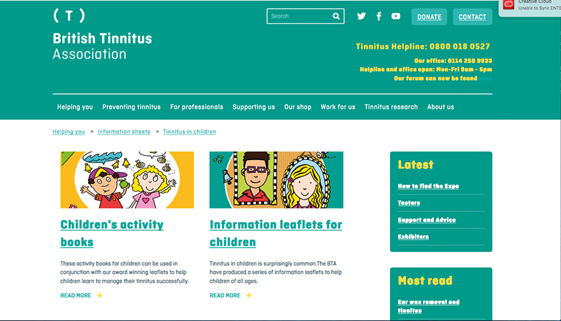What is your reaction when a patient reports having tinnitus? With the exception of audiologists and otolaryngologists who have developed expertise in the area of tinnitus, many of us feel ill-equipped to provide our patients with appropriate guidance. Trying to make sense of the information available is a huge challenge, especially for non-experts.
For professionals looking for straightforward resources to use with patients, the website for the British Tinnitus Association (BTA) is an excellent place to start: www.tinnitus.org.uk. The BTA is a UK-based independent charity with the aim of supporting tinnitus sufferers and the professionals who are tasked with helping them. The BTA works towards these aims on a number of fronts, including education and research.
It is well worth noting that almost everything available on the BTA site can also be downloaded in PDF format and later printed as a leaflet. Below, I will highlight some of the key resources available on the site for professionals looking to provide educational materials for their patients.
For professionals
This is an excellent section to review if you are looking for professional resources on tinnitus. The subcategories are directed at audiologists and GPs (note: the information in the GP subsection might be too general for some otolaryngologists). Under the audiology subcategory, there is an option called ‘Decision Aid’ that would be particularly useful for discussing treatment options with patients. The decision aid is a one-page table that displays some of the main general tinnitus treatment categories (e.g. ‘talking therapy’, ‘use of sound’) and explains each one in terms of frequently asked questions (e.g. ‘How does this approach help tinnitus?’) An excellent section called ‘guidance for GPs‘ includes information on tinnitus red flags, as well as general dos and don’ts when it comes to tinnitus counselling in primary care. The GP subsection also includes a PDF with a step-by-step guide for how to complete a primary care tinnitus consultation within eight minutes.
Helping you
The ‘Helping You’ tab on the BTA website contains information aimed at patient education. This is an excellent place to look for basic tinnitus information that can be easily printed and distributed to patients. The ‘Helping You’ drop-down menu contains an option for information sheets, where you can read or download information on subjects including ‘tinnitus’, ‘self-help’ and ‘supporting someone’.
Tinnitus in children
This is another section that is worth a look if you are seeking resources for children with tinnitus. It contains separate tinnitus guides for children, parents and teachers. There are also kid-friendly resources available, including printable activity books.
Preventing tinnitus
This tab contains basic information on tinnitus prevention. One of the subsections, called ‘how loud is loud’, explains the basics of noise exposure and how to tell what levels require noise protection.
In conclusion
The BTA website is packed with information that is presented in a readable and visually-appealing way. Though none of the technology presented is cutting-edge, the BTA website is a perfect example of how a well thought-out and simply designed website can be used as an effective educational tool for patients and professionals. The site is mobile-friendly so there is plenty of opportunity to make paperless adaptations for you and your patients.





